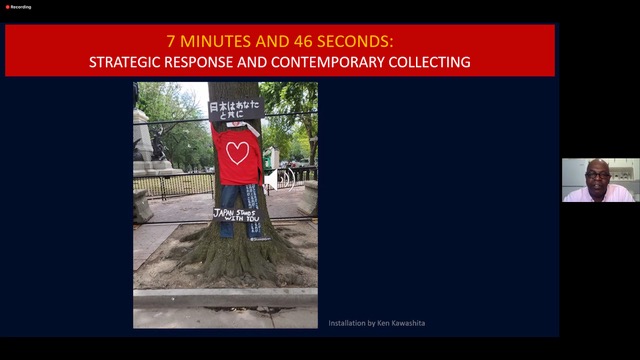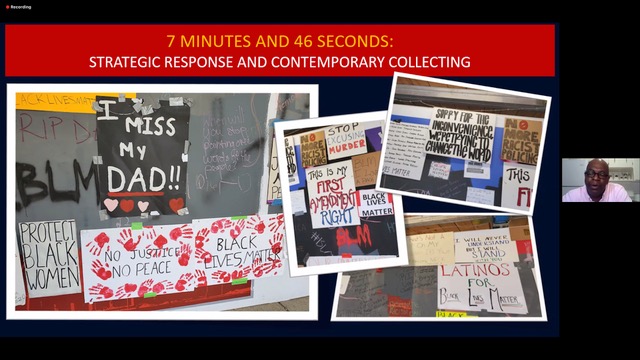
“7 minutes and 46 Seconds: Strategic Response and Contemporary Collecting from the Field of National Protests”
Aaron Bryant, Museum Curator, Photography, Visual Culture, and Contemporary History at Smithsonian National Museum of African American History & Culture
For its December 2020 meeting, the Washington Conservation Guild virtually hosted Dr. Aaron Bryant, Museum Curator of Photography, Visual Culture, and Contemporary History at Smithsonian National Museum of African American History & Culture. As a visual anthropologist and curator of contemporary history, Dr. Bryant shared his extensive experience with rapid-response collection practices, including his approach to collecting material related to the Black Lives Matter movement, as well as objects collected specifically in the wake of protests inspired by the murder of George Floyd.
Lafayette Square in Washington D.C. became the center of protest activity in the city following George Floyd’s murder in May 2020. The demonstrations raised questions regarding police brutality, racial equity, and the fragility of democracy, in both the American context and the global context, that marked a critical shift in contemporary history. In recording this particular moment in our country’s history, Dr. Bryant went to Lafayette Square seeking objects with stories that will resonate across generations. These objects will become symbols of this specific moment in history but also need to be relevant and powerful when they are displayed in one hundred (or two hundred) years.
A key tenet guiding Dr. Bryant’s collection practice is his deep interest in microhistories. These focused historical investigations into single objects, local or regional events, or specific communities and individuals are smaller and more personal in scope, informing our understanding of larger scale historical events. By centering objects that illustrate microhistories, Dr. Bryant seeks to represent the present moment from the multiple perspectives and voices that are participating directly in the historical record. Several case studies demonstrated the powerful nature of this kind of collection philosophy, including Dr. Bryant’s discussion of a sign from Lafayette Square with the message “I miss my DAD!!” as well as Ken Kawashita’s installation “Japan stands with you.” While there are many examples of protest signs with familiar slogans like “Black Lives Matter” and “Defund the Police,” the “I miss my DAD!!” sign struck a chord with Dr. Bryant with its more personal message. “It depoliticizes the experience in many ways. The sign is no longer about conflicting ideologies, but rather humanity and the human experience,” Dr. Bryant recounted.

In order to capture the fullest possible picture of this current historical moment, many different kinds of objects must be collected. Protest signs are critical artifacts to collect, but Dr. Bryant is also thinking about how to include other facets of the historical moment, such as the output of community arts programs (murals on boarded up windows, for example) and photography by emerging artists who are participating in protests. Photographers like Sheila Pree Bright and Devin Allen were in the streets making images of the events happening around them, composing and crafting photographs that stand alone as art objects as well as being important historical artifacts.
Dr. Bryant’s collection practice is one informed by the critical activity of collecting ideas as well as material objects. When thinking about future display of objects collected from this moment in history, Dr. Bryant considers the ways that a museum can serve a role in the community and how the institution can provide a platform for community members to engage with history. His curatorial and collecting work, grounded in a humanities-centered, microhistorical approach, is essential for conservators to understand when approaching the material condition of these objects.
3 December 2020
Summarized by Sarah Montonchaikul
4th year Graduate Intern in Objects Conservation, Smithsonian American Art Museum, Lunder Conservation Center